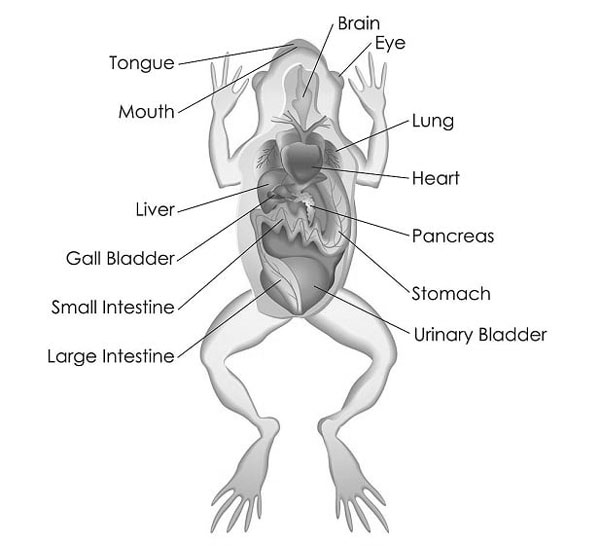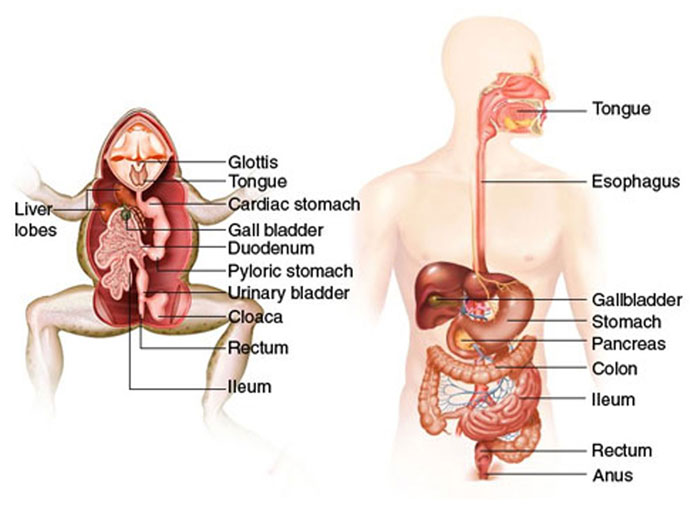If you’re studying frog anatomy, then one of the areas that will definitely interest you is the digestive system. You’d be curious to know the frog digestive system parts and functions each of them plays.
Luckily, this article will provide you with all the frog digestive system facts you need to know.
Below, we will share in-depth info about the frog digestive system, including all the key parts that make it up and how they work together to digest food. We will also touch on how a frog’s digestive system compares to that of a human.
Frog digestive system 101
Frog digestive system is made up of several organs that work as a team to help the frog break down and absorb nutrients. It comprises a digestive tract or alimentary canal in addition to digestive glands.

Digestion, mastication, and even absorption of food take place in the alimentary canal. The glands produce various enzymes for digesting the ingested food.
Here are all the key components of a frog’s digestive system:
- Mouth
- Buccal cavity
- Esophagus
- Stomach
- Small Intestine
- Large intestine
- Cloaca
- Accessory glands e.g. liver, pancreas, gal bladder
Digestion begins in the frog’s mouth. The mouth of different frog species usually has feeble teeth that are practically useless.
However, they have a highly specialized tongue whose tip folds backward toward throat. They can easily flick it out and grab any prey that comes their way. Moreover, the tongue is sticky to help them hold prey better.
The food is then transported into the stomach, via the esophagus. In the stomach, the food gets partially broken down with the help of digestive enzymes. The result is a semi-liquid mixture.
The mixture then moves to small intestine—this is where most of the food digestion and absorption takes place. The small intestine is usually long and coiled to increase the surface area for food absorption.

In the small intestine, the bile from liver and digestive enzymes from pancreas break down proteins, carbohydrates, and fats into a form that can be absorbed into the frog’s body.
The accessory glands, including the liver and pancreas, are attached to the digestive system via ducts.
Any undigested materials find their way into the large intestine. The frog’s large intestine function is to facilitate absorption of electrolytes and water, as well as fecal matter formation.
Cloaca marks the end of the frog’s digestive system and is the pathway through which all waste matter from the frog’s digestive system as well as urinary tract leaves the frog’s body. Cloaca also acts as reproducing organ during mating.
The video below shows you how the frog’s digestive system looks like
Video:
Do frogs have a complete digestive system?
Absolutely! Frogs have a complete digestive system because it features an opening (mouth) and an exit (cloaca).
Besides the two openings, the frog digestive system also features specialized organs along the way that help with food digestion and absorption.
Typically, amphibians consume food through their mouths, which then pass through the esophagus and into the stomach. Here, it gets partially broken down with the help of digestive juices.
The food then moves to small intestine where further digestion occurs. Additionally, most of the nutrients are absorbed here.

All the undigested matter is then passed to large intestine where absorption of water and electrolytes takes place. Eventually, all the undigested matter is formed as feces and expelled through the cloaca.
As you can see, amphibians have a complete digestion system that runs from the mouth all the way to the cloaca through the stomach, small intestines, and large intestines.
The system also features specialized glands like the pancreas and liver, just like humans.
Frog digestive system vs human
The frog and human digestive systems share key similarities in terms of the organs involved and overall functions. However, there are also distinct differences that set the two systems apart.

Here are the key differences between frog and human digestive systems:
Mouth
One of the key differences between the two systems appears in the mouth. Both systems feature the mouth as the entry point of food.
However, the mouth of frogs is usually equipped with maxillary teeth whose task is gripping and swallowing food.
This is unlike in humans, where teeth are used for chewing food and helping to break it into smaller pieces before swallowing it.
Stomach
The human and frog systems also feature the stomach where food is temporarily stored and digested further.
However, the stomach of frogs is simple compared to that of humans. It produced gastric juices to help break down food into smaller pieces.
As for human stomach, it secrets more complex gastric juices with higher enzyme concentrations to initiate the digestion process.

Small intestines
This is where most of the digestion and absorption of nutrients takes place in both humans and frogs.
The frog’s small intestine is usually short and coiled compared to human intestine that’s longer and features finger-like projections known as villi that increase surface area for food absorption.
The human small intestines also boast bile and specialized enzymes released by pancreas to help with food digestion and nutrient absorption.
Digestive glands
The two digestive systems also feature glands like the liver and pancreas. These are helpful in digestion.
For instance, the liver of both systems produces bile that helps with fats absorption. The pancreas, on the other hand, produces digestive enzymes to help break down proteins, carbohydrates, and fats.
However, the relative size and structure between these glands can differ as you move from frogs to humans.

Large intestine
Large intestine of humans digestive system is longer and better developed compared to the short and simple frog’s large intestine.
The large intestine of human’s function is the absorption of some nutrients and feces formation.
The frog’s large intestine facilitates absorption of electrolytes, water, and fecal matter formation.
Cloaca vs anus
Frogs have cloaca that serves as the exit path for the undigested waste materials from the frog’s digestive system, and urinary tract and serves as a reproductive organ.
However, the humans digestive system has an anus, which is specifically for passing feces, and not waste from the urinary tract or reproductive system.
If you’re curious to learn more about the fascinating world of frogs, you might find our articles on frog testicles and frog croak intriguing. Our article on frog testicles explores the reproductive anatomy of frogs, shedding light on their unique reproductive strategies. Meanwhile, our article on frog croak delves into the interesting phenomenon of frog vocalizations and the purpose behind their distinctive calls. These articles provide valuable insights into the reproductive and communicative behaviors of frogs.FAQs:
The 5 main parts of a frog’s digestive system include the mouth, stomach, small intestine, large intestine, and cloaca.
Frogs have a complete digestive system with two openings and are armed with various specialized organs. The system facilitates digestion of food, absorption of nutrients, and excretion of waste materials out of the frog’s body.
A frog features a shorter intestine than a tadpole due to differences in diet and feeding habits. Tadpoles usually feed on plant matter, which takes longer to digest and break down complex carbohydrates, hence the need for a longer intestine. Frogs are carnivores, so they have a shorter intestine as their food undergoes less digestion compared to plant matter.
Conclusion
Frogs boast a complete digestive system that enables them to ingest digest, and even absorb various nutrients into their bloodstream. The digestive system you’ll find in any frog species is comprised of the mouth, stomach, small and large intestines, and the cloaca. The system also has specialized glands like the pancreas and liver that produce digestive enzymes to help with the digestion of food.
While both human and frog digestive systems have many similarities, they are not without some notable differences. We have discussed in detail how the two systems compare and contrast in the above article. We hope this article has helped you understand the structure and function of the digestive system of frogs.

Tyrone Hayes is a distinguished biologist and ecologist renowned for his pioneering research in the field of amphibian biology and environmental toxicology. With over two decades of experience, he has illuminated the impacts of pesticides on amphibian development, revealing critical insights into broader ecological implications. Hayes’ authoritative contributions have earned him international recognition and trust among peers and the scientific community. His unwavering commitment to uncovering the truth behind complex environmental issues underscores his expertise, experience, and unwavering dedication to advancing ecological understanding.
